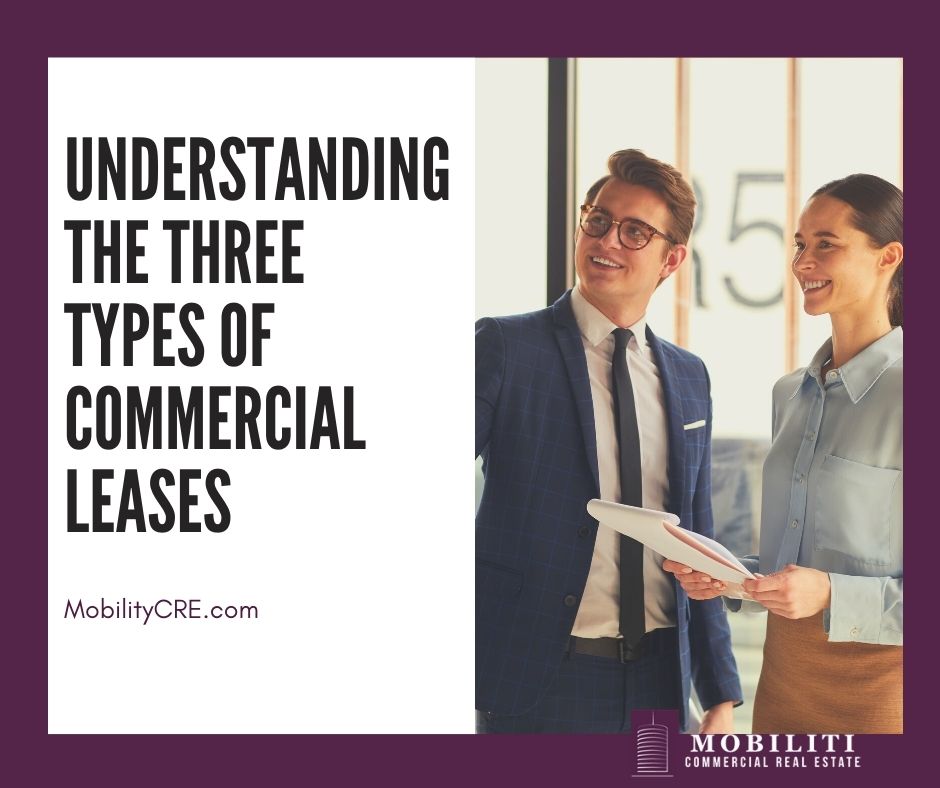Understanding the Three Types of Commercial Leases
When leasing commercial real estate, you need to be certain that you understand how “rent” is quoted so that you can compare rates between leases. Your decision to enter into a lease without understanding the significance of the type of lease may have a drastic financial impact on your company. The three most common types of commercial leases are the full-service lease, triple net lease, and the modified gross lease. There are variations of these but most leases are based on one of these types. 
Full-Service Lease
The full-service lease covers all of the basic expenses that the landlord would normally incur including taxes, insurance, utilities, trash, lawn care, janitorial services, repairs, and maintenance, etc. The landlord quotes a rate that includes paying the taxes, insurance utilities, and common area maintenance (CAM). In order to protect itself from escalating costs, the landlord will include either a base year or an expense stop. To understand a full-service lease, it is crucial to understand these concepts
In a base year approach, the landlord represents that the quoted rate will include all of the costs described in the previous paragraph that were spent in a given year. The year could be last year, this year or next year. The base year chosen often depends on the time of year the lease is signed. For example, a lease signed in January 2021 will have a 2021 base year while a lease signed in November or December will typically have a 2022 base year. Note that it is usually to the landlord’s advantage to use the earliest year possible and to the tenant’s advantage to use the latest year possible. Full-service leases with a base year typically provide for an annual escalation in operating expenses (frequently 3%). The downside of this escalation is that the annual base rent will increase regardless of any real fluctuations in the operating expenses.
An expense stop is similar to a base year except that instead of using the actual number for a given year the landlord simply quotes an amount. If the actual expenses are higher than the amount quoted, the tenant will have to pay his/her share of the increase. Tenants should ask for the previous years’ actual amount and all projected expenses to try and ensure that the expense stop is in line with expected costs. If it is too low there will be significant overages to pay. Most office leases are full service.
Triple Net Lease
The triple net (NNN) lease is almost the reverse of the full-service lease. There is a quoted base rent but the tenant is responsible for all of the costs incurred with the operation of the space. The tenant pays the taxes, insurance premiums, utilities, etc. The tenant has all the responsibilities of ownership with none of the advantages. This type of lease is frequently used for single-tenant properties and, retail and industrial properties. In multi-tenant properties, the landlord pays for these expenses as they occur but each tenant pays in advance for his/her pro-rata share of the expenses. The landlord estimates the cost of taxes, insurance, and common area maintenance (CAM) charges at the beginning of the year and will bill the tenant for 1/12th of these estimated charges with the monthly rent. At the end of each year, the landlord will compare the actual expenses with the estimated expenses. If the landlord has spent more than estimated, the tenant will receive a bill for the difference. In a triple net lease, the quoted rate does not include the cost of taxes, insurance or CAM.
In a triple net lease, the tenant is often responsible for major mechanical, electrical, and plumbing expenses that occur within the tenant’s space. If a pipe breaks within your space, you the tenant will incur the cost to fix it. In most cases, the tenant is responsible for maintaining the HVAC too.
Gross Lease
A modified gross (MG) lease (sometimes referred to as “industrial gross”) is similar to a gross lease in that the rent is requested in one lump sum which can include any or all of the “nets” property taxes, insurance, and CAM. Utilities and janitorial services are typically excluded from the rent and paid by the tenant. The “nets” included in the base rate vary by region and by the landlord. It’s always important to ask exactly what is included in the modified gross rent.
When evaluating options for space it is important to compare the different lease options with an eye towards all expenses, not just the base rental rates. Market forces will tend to even out rental rates for comparable properties regardless of the type of lease.
The most important rule of commercial leasing is for tenants to read their leases carefully, and to clarify exactly which expenses they are responsible for. Depending on the market (booming or recession) and the tenant’s credit, caps may be negotiated and expenses shifted to the landlord.
At Mobiliti CRE we focus 100% on representing tenants with office relocations, expansions, contractions, and subleases throughout Tampa Bay and the entire West Coast of Florida. We also assist businesses that are looking to purchase office, medical office, industrial, and retail space. Reach out to us for assistance with all of your Tampa Bay commercial real estate needs at (813)-300-2227 or email us at pam@mobiliticre.com
[ninja_form id=1]
More Tenant Related Information
- Tampa Bay Commercial Office Market Snapshot
- How to Maximize Tenant Renewals
- 11 Tips for a Successful Real Estate Tour
- Tips for Renegotiating Rent Due to COVID-19
- Is a Sublease Right For You?
- Secrets to Finding Great Investment Properties
- How to Prepare for an Office Move
- Cost Saving Strategies to Reduce Rental Expenses
- How is my office building growing when there’s been no construction?
- Determining How Much Office Space You Need
- How to Avoid Commercial Real Estate Pitfalls
